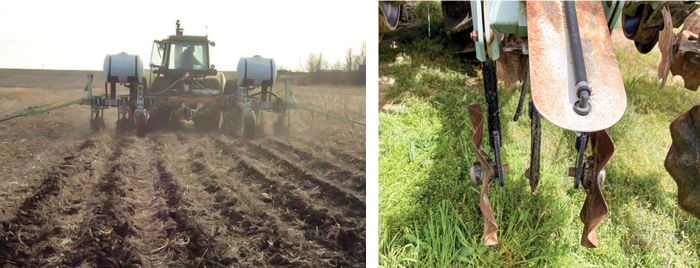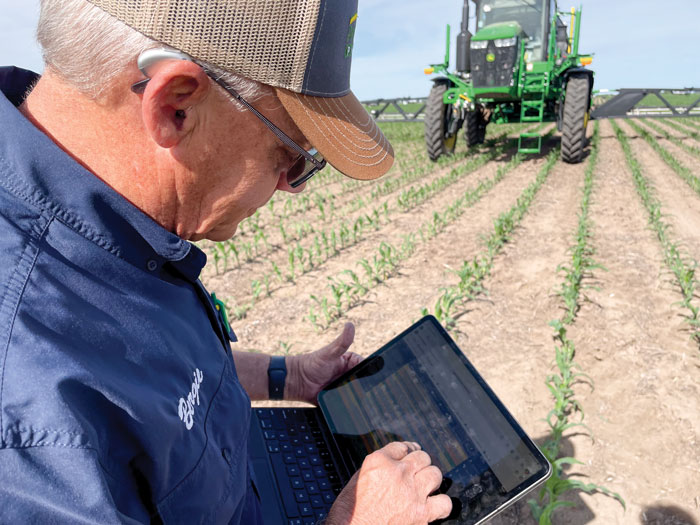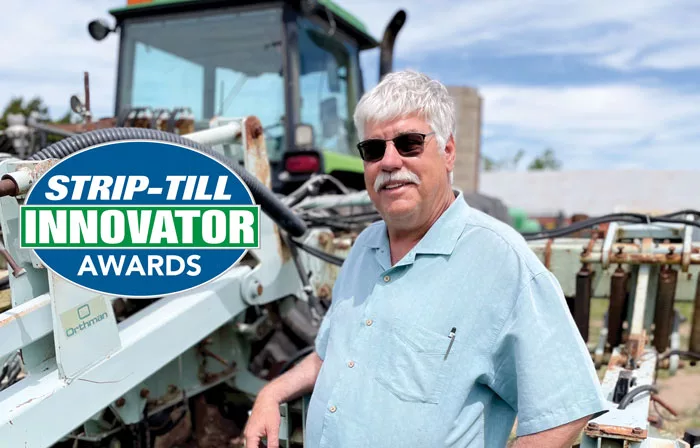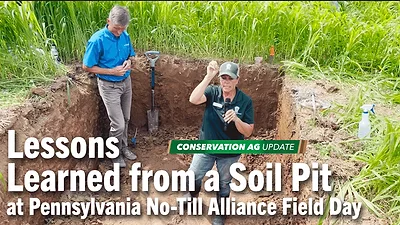TAKEAWAYS
- Don’t be afraid to call an audible if Mother Nature throws a wrench in your strip-till plans.
- Spacing out nitrogen (N) applications throughout the season ensures the crop has what it needs to make it to the finish line.
- Proper weight distribution on the tractor will help the planter stay on the strips.
It’s hard to miss the giant Flickner Innovation Farm sign from the side of the road while driving around Ray Flickner’s 1,000-acre corn, soybean and wheat operation in Moundridge, Kan.
Innovation is the name of the game for the 5th-generation farmer, who was one of the first in the area to adopt strip-till in the early 2000s — just a few years after breaking the mold with subsurface drip irrigation.
“Being the first to strip-till is like putting a bullseye on your back and saying, ‘Well, what can go wrong here?’ But I have several neighbors who say the reason they started strip-tilling is because they saw what I did and they liked the concept,” he says.
Ray’s use of cutting-edge technologies and management practices to conserve water and boost soil health — and willingness to put everything under a microscope for all to see — makes him more than worthy of the 2025 Strip-Till Innovator Award.
Legacy of Conservation
The Flickner family tradition of innovation dates back several years to Ray’s father, Galen, who always thought outside of the box.
“Dad was trying to farm on a shoestring budget,” Ray recalls, “which is why he tried different things like moving away from anhydrous applications in the 1970s and transitioning to minimum tillage because he didn’t have the capital to buy all the equipment.”
“Several neighbors say they started strip-tilling because they saw what I did and liked the concept…”
Ray and his late wife, Susan, picked up where Galen left off, tapping into their passion and experience as teachers to find and share even more ways to farm smarter. They received the prestigious Leopold Conservation Award for their dedication to conservation practices in late 2023, shortly before Susan passed away.
“Susan and I have been blessed with a multi-generational legacy,” Ray says. “We committed ourselves and taught our children, who are in turn teaching our grandchildren, that we must leave the land in a better condition than how we found it.”
School of Hard Knocks
Ray learned through the “school of hard knocks,” as his son Ryan puts it, when he started experimenting with strip-till in the late 1990s. At the time, there weren’t many strip-tillers in the area to turn to for advice.
Ray experimented with fall and spring strip-till before ultimately discovering the need for freeze-and-thaw action in his heavy crete silt loam soils before planting. He makes his strips in December after he’s done harvesting corn and soybeans and no-tilling winter wheat.

ONE TRIP. Flickner made his toolbar a true “one-tripper” by retrofitting it to apply herbicide while making strips. Noah Newman
“During my first strip-till experience, I tried to do it in the spring when it was too wet,” Ray says. “I went backwards big time. The soil smeared and never healed. Now, if we haven’t strip-tilled a field by the middle of January, then we just won’t do it at all. Last fall was wet, and we couldn’t get around to strip-tilling one field, so we just no-tilled it.”
Ray eventually transitioned all his corn acres to strip-till in 2005 after a few seasons of trial and error. He bought an Orthman 8-row 1tRIPr and retrofitted it to apply herbicide while making strips about 6-8 inches deep.
“We didn’t own a self-propelled sprayer until about 2018, so being able to apply herbicide in one pass behind the strips was very beneficial,” Ray says.
Precise Nutrient Management
Every field is grid sampled once every 4 years to measure soil health and determine fertilizer rates.
Ray’s nutrient management plan usually includes a 40-gallon mix of urea ammonium nitrate (UAN-32) and ammonium thiosulfate (ATS) and 10 gallons of 10-34-0 applied with the strip-till rig, which makes up about 25% of the total nitrogen (N) program for corn.
The other 25% of N is applied via starter fertilizer with the planter and the remaining 50% is spoon-fed in season through subsurface fertigation.
“Strip-till makes a lot of sense because it gives us the ability to place fertilizer in the root zone and plant right on top of it,” Ray says. “Plus, there’s no disturbance between the strips. The residue helps boost soil life, keeps the ground cooler in the heat of the summer and acts like a sponge when we get rain.
“We have a living root growing throughout the year…”
“Now, the challenge is making sure the planter stays on the strips,” he adds. “I had a neighbor plant one of my fields with a 16-row planter recently and he had a hard time keeping it on guidance with the strips. If you don’t have a lot of weight on the front end of the tractor, it will pull you around pretty good, and you’ll start fighting the strips.”
A few years ago, the Flickners made the decision to hire neighbors with the “latest and greatest” equipment to custom strip-till and plant most of their acres. The move not only saves time but also allows them to spend money elsewhere.
“Any farmer has limited resources and we’ve chosen to invest our capital in innovative projects and equipment like a 360 RAIN unit,” says Ryan, Ray’s son. “It was the same thing with strip-till. We put quite a bit of capital into our strip-till toolbar, but it was only 8 rows, and getting across hundreds of corn acres took some time. It’s more economical for us to pay the neighbor to custom strip-till our corn because they have the bigger toolbars.”
Living Roots Year-Round
Ray’s crop rotation consists of no-till drilling wheat into corn stalks, no-tilling double crop soybeans into the wheat stubble, and strip-tilling soybean stubble ahead of corn on the acres with irrigation pivots.
“We’re 13 inches below normal rainfall this year and we only average around 33 inches annually,” Ray says. “We had an inch of rain 10 days ago and that was the most we’ve had in almost 5 months. With the pivots, where I can apply water over the top, I do the corn-wheat-soybean rotation because I can water everything up to germinate. But it’s riskier with subsurface drip irrigation, which is why I use cover crops instead of wheat on those acres.”
Innovation in Action
The camera was rolling as Strip-Till Farmer toured Ray Flickner’s farm in Moundridge, Kan. Click here to go behind the scenes with Ray and Ryan Flickner in the 2025 Strip-Till Innovator video series, sponsored by LandLuvr. The series includes the following 6 videos:
- Ray Talks Crop Rotation, Strip-Till Benefits & Challenges
- Improving Water Use Efficiency with Autonomous Pivot
- Ray & Ryan Showcase their First Toolbar
- Local Deere Dealer Tests New Tech at Flickner Innovation Farm
- Subsurface Drip Irrigation is a Difference Maker for Strip-Till Innovator
- Adding 360 RAIN to the Precision Arsenal
On the 600 acres with subsurface drip irrigation, soybeans are often planted into a cover crop mix of cereal rye and turnips that’s drilled in late September. Ray planted green into chest-high cereal rye in the wet spring of 2019, but he usually terminates the cover crops about a month before planting if conditions are dry, like they have been the last 5 years.
“We’re growing 3 cash crops in 2 years,” Ray says. “We have a living root growing throughout the year with the exception being between soybeans and corn on some acres. I’m still searching for a cover crop mix that works well before corn on our farm.”
The Flickners have experimented off and on with strip-tilling soybeans, but Ryan says they haven’t been able to consistently crack the 80-bushel mark.
“Whether it’s the variety or the weather, we haven’t been able to get those racehorse yields with strip-tilled soybeans yet,” Ryan says. “When we try something new, we always look at the ROI. Is the goal to go to the coffee shop and brag about the highest yield? Or are we trying to manage our farm to be the most profitable?”
Below the Surface
Spend just a few minutes with Ray and Ryan and it doesn’t take long to see they’re laser-focused on water conservation. A recent study by Kansas State revealed the Flickners use about 40% less water than the county average.
“This kind of breaks my heart,” Ryan says while driving by a nearby field that’s being watered in early May. “Not to pick on anyone, but why are they watering wheat and corn right now? There’s a really good chance of rain on Sunday, Monday and Tuesday.”
“For a long time in the irrigation community, the idea was that you couldn’t put on too much water,” Ray says. “But we discovered that we could reduce the amount of irrigation application and still maintain yield and improve our profitability.”

WATERWORKS. The Flickners leave no stone unturned in their quest for water conservation. They use 40% less water than the county average by leveraging subsurface drip irrigation, mobile drip irrigation and the first 360 RAIN autonomous irrigation unit in Kansas. Noah Newman
The family used a gated pipe irrigation system for a long time, but by 2000, Galen’s health was declining, and Ray was on the road quite a bit for his full-time job in the ag finance world. Something had to change.
“It became a labor issue, we just didn’t have the labor anymore,” Ray says. “Also, pivots don’t work on all our acres because we have some creek and farmstead obstacles in the way. We were ending up with a lot of wasted acres. I saw the subsurface drip irrigation concept in Arizona and California and decided it could work for us.”
Ray gave it a shot in 2001, installing a Netafim Subsurface Drip Irrigation system, which uses buried drip tape — installed 18 inches below the soil surface — to deliver water directly to the root zone throughout the growing season. They also use the system to inject fertilizer like UAN when the crop needs it.
“It’s an automated system, kind of like what you normally see with a residential sprinkler system,” Ray says. “There’s a control box. Originally, we were pneumatic, but we converted everything to radio frequency, so I can control it from the house. We plug in which zones we want watered and for how long. It was an expensive proposition, but it’s paid off through labor savings and improved water use efficiency.
“The biggest downfall with it is the inability to germinate a crop if you don’t have moisture at planting,” he adds. “But if we do get a rain in the summertime, the ground is like a sponge and there isn’t much runoff. Whereas if you have a wet surface from a pivot, there would be some runoff. I also think the drip irrigation improves weed control because if the weeds don’t have moisture, they won’t grow.”
“We could reduce the amount of irrigation application and still maintain yield and improve our profitability…”
The drip tape runs the length of the field and there’s 60 inches between each tape, which decreases the margin for error with strip-till. If corn is planted right on top of the drip tape, every other row would have a long way to go for water.
“Since there’s 60 inches between drip tape and we plant in 30-inch rows, we want the strips to be 15 inches away from the drip tape,” Ray says. “The concept is to match the distance from the plant to the drip tape and make sure that’s constant across the field.”
About 60% of the farm has subsurface drip irrigation. The Flickners use even more cutting-edge technology on the other 40% to make sure their water use efficiency is up to par. In 2019, they installed Netafim Precision Mobile Drip Irrigation. The system retrofits to a pivot, combining the efficiency of surface drip irrigation with the flexibility of center pivot and linear move irrigation systems.
More recently, they became the first farmers in Kansas to run a 360 RAIN autonomous irrigation system from 360 Yield Center. It provides water and nutrients to the base of the plant as it moves through the field.
They’re also using an Autonomous Pivot system on some fields. It’s an AI-driven platform that uses sensors and cameras to provide up to 300 soil moisture readings per rotation without disturbing the soil.
“The advantage of this system is it moves around with the pivot,” Ray says. “It gives us a better idea of the exact moisture content in the field, so we know if we need more water or if we’re watering too much.”
Ahead of the Curve
It’s not uncommon for Ray to have at least a dozen research trials taking place simultaneously on 80-acre fields known as the Flickner Innovation Farm — launched in 2019 as a testing ground for new farming technology and conservation practices on a large scale.
The initiative has evolved into a collaboration between more than a dozen university, industry and agency partners, and culminates with a field day usually every other summer to share key takeaways from the trials and give farmers an up-close look at precision technology in action.
“There’s only so many of us, and a lot of people don’t want to share their information,” Ryan says. “We make our yield maps and everything else public. That was a decision we made to help the neighborhood, the community and agriculture as a whole. Let’s figure out how we can use our resources better. Mom and Dad were educators, so it was always near and dear to their heart to have that philosophy of sharing what we learn with an external audience.”

INNOVATION FARM. Bryan Berggren, product innovation specialist for John Deere dealer PrairieLand Partners, conducts a See & Spray trial on an 80-acre field at the Flickner Innovation Farm. Noah Newman
The Flickners are partnering with local John Deere dealer PrairieLand Partners to test John Deere See & Spray, ExactShot and Predictive Ground Speed Automation on one of the fields during the 2025 growing season.
“Kansas State will come out and help us conduct the research, so the data is coming from a third party,” says Bryan Berggren, product innovation specialist with PrairieLand Partners.
Some initial takeaways from the Deere technology trial include up to 60% herbicide savings with See & Spray and little visual difference between early-emerging corn under a normal fertilizer program and corn where less fertilizer was target-applied with ExactShot.
“Farming is definitely an ongoing learning curve and that’s why I appreciate the ability to work with Ray and Ryan,” Berggren adds. “It’s hard to find people like the Flickners and partnerships like this. It just doesn’t happen often.”
The Flickner Innovation Farm even piqued the interest of NASA scientists, who paid the Flickners a visit in 2023 during their “Space for Ag” listening tour to learn more about the challenges farmers faced with water resources in a drought year.
Ray learns something new every year, and he’ll continue exploring ways to improve the long-term outlook of his farm for future generations because innovation has always been part of his DNA.
“Some of my former bosses in the ag finance world would say, ‘Ray, you need to stop thinking so much, just keep doing the same thing.’ I remember supervising 35 people for one of my jobs,” Ray recalls, “and I drove everybody crazy because every time we did a project, I tried to tweak it and do something different.”








